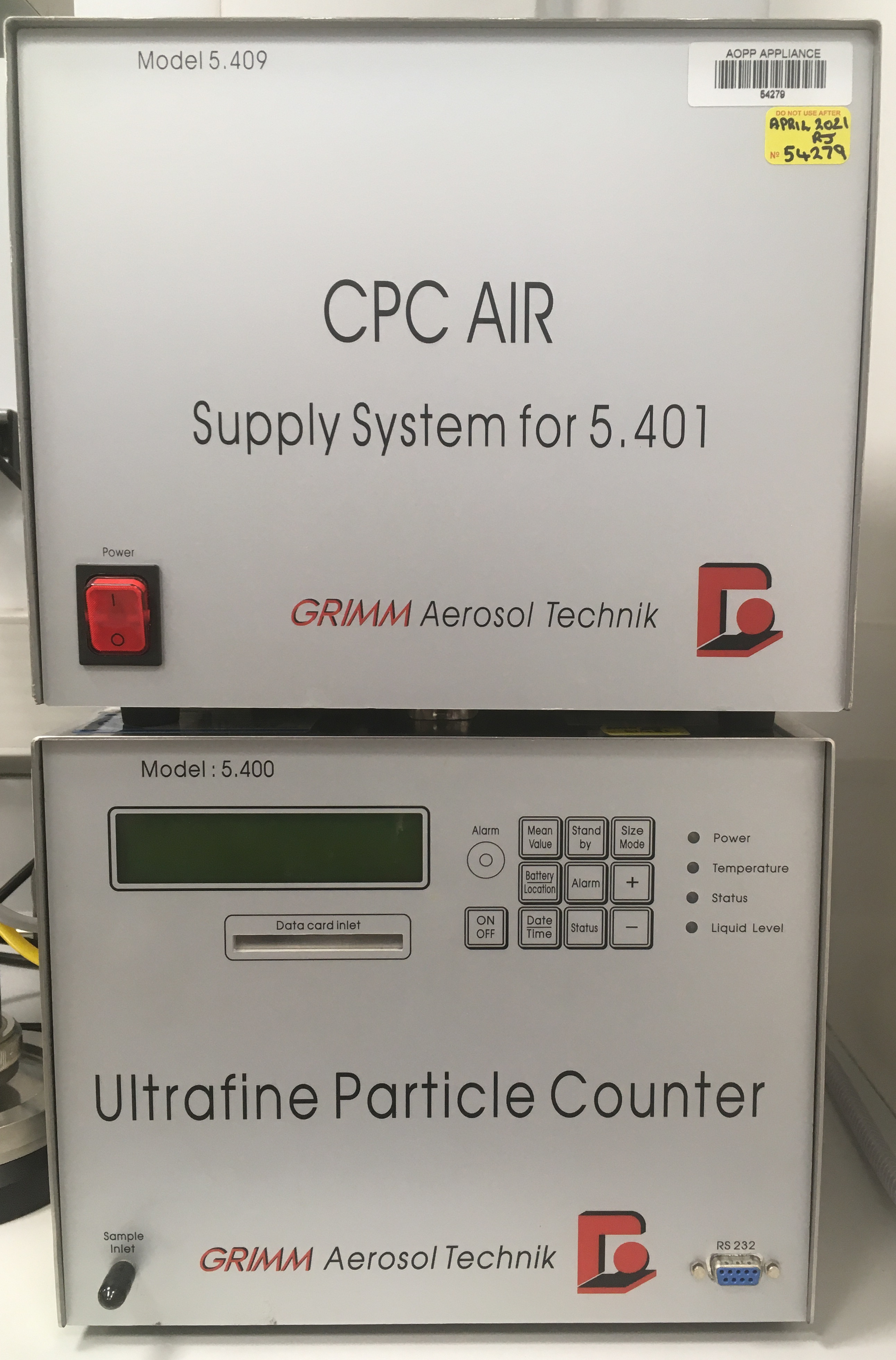 |
 |
 |
 |
 |
 |
 |
 |
 |
|||
 |
 |
||||||||||
GRIMM Condensation Particle Counter
CPCThe CPC is used to find the concentrations of particles that are too small to be counted by usual light scattering mechanisms. It works in real time by the principle of nucleous condensation. Liquid vapour condenses onto the small aerosol particles and these scatter light that is then measured. Butanol is used as it is more efficient to use this than water. The CPC may be battery operated if required and has a port for the attachment of external analogue sensors. It may also be remotely operated via a modem and has a data storage card for fieldwork. p>Contents:
HOW IT WORKSThe monodisperse aerosol sample enters the CPC via the sampling tube and travels to the saturator. SaturatorAt the saturator the aerosol particles cross a heated N-butyl-alcohol saturation pipe that is at a temperature of 35 C. The butanol is kept in a felt sponge to avoid spillage and damage to the instrument. There is an automatic supply of butanol to the sponge from an integrated alcohol tank. The supply is controlled by an internal sensor. The butanol tank may be refilled by attaching a bottle to the appropriate port outside the instrument (see Care and Maintenance) when the CPC is in standby mode. The cap of the bottle should be removed in order to allow the butanol to flow. CondensorThe aerosol particles and alcohol vapour then enter the cooling condenser unit. This is at a temperature of 10 C. Supersaturated alcohol vapour condenses on aerosol particles whose size is increased to ~10 µm. Information on the size of the particle is lost here. Every aerosol particle receives a single droplet of alcohol and this is controlled by a carefully managed saturation level. There is no alcohol droplet without an aerosol particle at its centre. Note that condensation of ambient humidity in the condenser can dilute the butanol and reduce the efficiency of the instrument. There is therefore an automatic micropump positioned before the condenser in order to remove this fluid before it runs back into the saturator. The peristaltic pump works automatically when the reservoir is attached to the outside of the instrument, at the relevant port. Only water that runs down the condenser walls is collected and pumped out, since water molecules have a very high diffusion rate and very quickly hit the walls of the condenser. OpticsThe droplets cross a laser beam and light is scattered by them onto a photodiode. The signals are counted continuously, in real time. Signals are counted per second and data is displayed in counts per ccm before being stored. FilterAn active carbon filter is located above the laser optics, before the outlet in order to reduce alcohol odours and particle emissions to the environment. Removable Data CardData may also be stored onto a removable data card for fieldwork. The internal battery will last for 4-5 hours depending on external conditions such as the temperature and whether the DMA is connected etc. When the memory card is first inserted into the CPC, the instrument will display the amount of data space remaining on the card. Data may be exported as a .txt file or directly into Excel as a spreadsheet. SETUP PROCEDUREFor safe operation, an external fuse must be inserted before the CPC is used. This should be just a low voltage fuse for the battery within the CPC. When the machine is first switched on, the date and time will appear. The machine will then ask whether you wish to initiate warm-up. The warm-up procedure will start automatically soon after the machine is switched on if no instructions are given. The settings of the instrument for any particular reading may be controlled and set using the Windows software program. Attach the reservoir to the appropriate port to collect condensation from the condensor. A green LED at the rear of the device displays the butanol level. To top up the butanol level, attach the external refill bottle and remove the cap. Make sure the CPC is in Standby mode. To switch to Dryer mode from Charge mode, press set-up and standby. Pressing 'Alt 1 2 4' in the Windows software will put the instrument into Service mode. Further information will then be offered with each command given BUT the instrument will not register errors in this mode and so will continue taking readings even if there is a problem e.g. no butanol. To return to the normal operation mode, press 'Alt 1 2 4' again. CPC MEASUREMENTSRaw data is outputted from the instrument and recorded in a measurement file. 'Scans' can be completed which involve very small repeating steps. The voltage steps of the scan are dependent on the DMA. Scans can only be completed over a 300 second period. Every other bin in a scan may be skipped in order to reduce the amount of time taken for the scan - these values are instead calculated by the software. For further information on the scanning methods see Colin, Flagan et al. (2001). INSTRUMENT LIMITATIONSThe instrument will NOT work if :
The internal battery will last only 4-5 hours but this is dependent on conditions. The instrument is able to count up to 1×1010 particles per ccm and the data is displayed in counts per ccm. It can measure particles in the size range 5 nm-350 nm in 44 channels. The SMPS+C is not designed to be operated when the ambient temperature is greater than 30 C. There is a separate adapter for high temperature use but this requires more energy. DOS AND DON'TSDO remember to top up the butanol. This can only be done when the instrument is in Standby mode (see Care and Maintenance). DO remember to insert an external fuse for safe, correct operation. This should be just a low voltage fuse for the battery within the CPC. DO remember that it is necessary for the aerosol to be stable for at least 1 minute for an accurate CPC measurement. DON'T forget to keep the instrument upright whenever possible. If it is kept in the wrong position for long periods of time, the butanol sponge will drip and damage the instrument. The instrument should never be put on its side unless it has been dried out. DON'T forget to dry out the instrument thoroughly before transport in order to avoid flooding and damaging the instrument. To switch to Dryer mode from Charge mode, press set-up and standby. The Dryer mode runs automatically for approximately 12 hours, after which time the instrument will switch itself off. DON'T operate the instrument without the condensor reservoir attached or condensation will lead to dilution of the butanol and inaccurate measurements. DON'T CHANGE ANY SETTINGS IN THE SERVICE MODE UNLESS YOU ARE ABSOLUTELY CERTAIN OF THE OUTCOME. CARE AND MAINTENANCEThe butanol level should be monitored and topped up when necessary. A green LED at the rear of the device displays the level. To top up the butanol level, attach the external refill bottle and remove the cap. The internal butanol tank should only be filed up when the instrument is in standby mode. If the bottle is attached otherwise then the instrument will take any butanol it requires directly from the bottle, but will not refill the internal tank. The reservoir for removal of condensation from the condensor walls should always be attached before use and emptied regularly. The instrument should be kept upright as much as possible. When being transported the CPC should be kept in its carry case which should be pulled along using the handle at the top of the case and NOT the handle on the side. The instrument should always be dried out before long periods of transportation. The instrument should never be operated without the attachment of a fuse. |
||
| Earth Observation Data Group, Department of Physics, University of Oxford. | Page last updated: @20:23 GMT 11-Sep-2025 | |